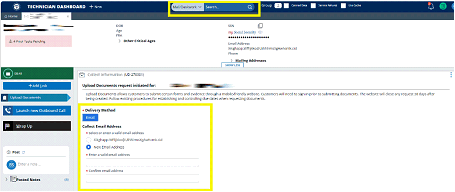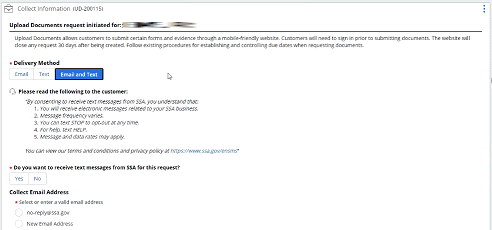Retention Date: 08/26/2025
A. Purpose:
This EM provides new and updated instructions for collecting customer electronic communication preferences (text, email, or both) and consent if the customer opts to receive text messages from us. This supersedes the previous guidance in EM-24015 regarding the need to obtain consent for email communications.
NOTE: This document uses the terms "eSignature/Upload Documents" and "Upload Documents" to refer to distinct concepts. "eSignature/Upload Documents" specifically denotes the product, while "Upload Documents" refers to the task a technician can initiate in Technician Experience Dashboard (TED).
B. Background:
Prior to September 28, 2024, technicians used email as the sole means to communicate with customers to initiate an Upload Documents request. eSignature/Upload Documents had required technicians to obtain customer consent prior to sending emails requesting document submissions.
Effective with the release on September 28, 2024, eSignature/Upload Documents will no longer require the collection of customer consent in TED for email messaging.
Additionally, text messaging will be added as a communication option in TED. Technicians must collect customer consent before sending text messages.
C. Email Communication Enhancements – Customer Consent No Longer Required for eSignature/Upload Documents Emails
eSignature/Upload Documents no longer requires customer consent to send emails related to a single request.
D. Email Only Communication Option Using Mail/Deskwork – Customer Consent Not Required for eSignature/Upload Documents Emails
Technicians using the Mail/Deskwork function do not interact with the customer, therefore they may initiate an Upload Documents task without verifying a customer’s identity. Technicians will notice that the electronic communication options are restricted to email only in this view. Text messaging is not available for Mail/Deskwork because customer consent is required for text messaging.
If the customer has an existing My Social Security account, the customer’s email address is propagated in the email address section within the Mail/Deskwork dashboard. Other potential options to locate a customer’s email address include: the appointment leads screen, iClaim, the remarks section of applications, special messages on MBRs, or a Report of Contact (RPOC). However, if technicians are unable to locate the customer’s email address, they will need to contact the customer to collect the customer’s preferred electronic delivery method and consent, if applicable. See instructions in Section E for collecting customer preferences.
 Figure 1 Mail/Deskwork View - Email Delivery
Figure 1 Mail/Deskwork View - Email DeliveryFor all other customer interaction types that are not Mail/Deskwork where the technician is speaking to the customer either by phone or in person, they will begin by verifying the customer’s identity. After verifying identity, the technician will add the Upload Documents task and then select their desired electronic communication method.
Customers can choose to receive emails, text messages, or both related to their Upload Documents request. Depending on the customer’s preferences, technicians will then be prompted to enter the customer’s existing or preferred email address and/or a text enabled phone number. If the customer prefers to receive email only, technicians will not be required to obtain consent, as discussed in Section C. If the customer prefers to receive text messages, the technician will obtain their consent as discussed in Section G.

Figure 2 Customer Communication Preferences
F. Text Communication Enhancement – Customer Consent Required
eSignature/Upload Documents may include the following text message notifications:
· An initial text message welcoming the customer to SSA Messaging that includes a link for more information.
· A second text message sent simultaneously that contains instructions and an access link to submit requested documentation through eSignature/Upload Documents.
· A follow-up text message sent 10 days after the initial contact to remind the customer to submit the previously requested evidence or documentation if the submission has not been received.
· A confirmation text letting the customer know their submission was successful.
IMPORTANT: The customer’s consent will only apply to a single Upload Documents request within TED. Technicians will need to collect the customer’s consent for text messaging for each new/subsequent Upload Documents task request that is sent to the customer.
The text message access link remains active for 30 days (same as the pending task in TED), or until the customer successfully submits the required documentation or evidence, whichever occurs first.
If the submission is not received within 30 days, as with email notifications, TED automatically closes the request, and no further messages are sent.
Technicians should continue to follow existing procedures and policies for sending closeout letters and follow-up notices (GN 01010.410, GN 01070.325).
NOTE: eSignature/Upload Documents emails or text messages are not intended to replace these existing policies or procedures.
G. Collecting Customer Consent for Text Messages:
Effective with the release on September 28, 2024, the technician will capture the customer’s consent to receive multiple, automated text messages related to their Upload Documents request. The technician will confirm that the customer wishes to receive information related to their Upload Documents request by text message as follows:
Step 1: The technician reads the following:
“By consenting to receive text messages from SSA, you understand that:
· You will receive electronic messages related to your SSA business.
· Message frequency varies.
· You can text STOP to opt-out at any time.
· For help, text HELP.
· Message and data rates may apply.
You can view our terms and conditions and privacy policy at https://www.ssa.gov/ensms”.
Step 2: The technician records the customer's consent to receive text messages in TED by selecting the “Yes” button by the following message: “Do you want to receive text messages from SSA for this request?”
If the customer does not consent to receiving text messages, the technician has the following options to complete or cancel the task:
NOTE:
· Consent to text messages is voluntary.
· Customers may opt-out from text messages.
· The technician will add and record in TED the customer’s text message consent, which is only valid for the single Upload Documents request.
H. Manual Opt-Out from Text Messages
Customers can manually opt-out or unsubscribe from text messages by responding “STOP” to any text message. Refer to SSA’s messaging policy (ssa.gov) for more information.
I. Automatic Opt-Out from Text Messages
As with email messages, customers are automatically opted out of continued text communications related to the request after 30 days (same as the pending task in TED), or until the customer successfully submits the required documentation or evidence, whichever occurs first.
Once SSA receives a customer’s submission(s), the technician receives an alert in TED, and the document is routed to SSA’s electronic repository. The pending task in TED will close and the text communications automatically stop for the customer.
J. Closing paragraph:
Direct all program-related and technical questions to your Regional Office (RO) support staff using vHelp or (PC) Operations Analysis (OA) staff. RO support staff or PC OA staff may refer questions, concerns, or problems to their Central Office contacts.
References: